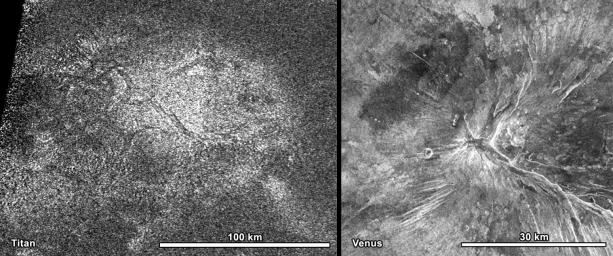NASA's Cassini spacecraft obtained this image of a feature shaped like a hot cross bun in the northern region of Titan (left) that bears a striking resemblance to a similar feature on Venus (right). The Titan image was obtained by Cassini's radar instrument on May 22, 2012. The bun is located at about 38.5 degrees north latitude and 203 degrees west longitude. This image is taken from a longer radar swath, which is about 3,200 miles (5,200 kilometers) long and about 400 miles (600 kilometers) at its widest.
The circular feature shown, which looks like a giant hot cross bun, is about 43 miles (70 kilometers) in diameter with near-perpendicular markings about 37 miles (60 kilometers) wide, meeting at its center. The illumination for this synthetic aperture radar image is from the right. Similar features are seen on other planets. In a synthetic aperture radar image of Venus by NASA's Magellan spacecraft, this radar-bright circular-shaped region of 20 miles (30 kilometers) across lies at the summit of a large volcano called Kunapipi Mons (at about 33.3 degrees south latitude and 85.5 degrees west longitude on Venus). This comparison leads to the interpretation that the Titan crosses are also fractures caused by uplift from below. Steam often causes the top of bread to lift and stretch, but on Titan some other force, such as rising cryomagma, may have uplifted the surface, leading to the crossed cracks.
The Cassini-Huygens mission is a cooperative project of NASA, the European Space Agency and the Italian Space Agency. NASA's Jet Propulsion Laboratory, a division of the California Institute of Technology in Pasadena, manages the mission for NASA's Science Mission Directorate, Washington, DC. The Cassini orbiter was designed, developed and assembled at JPL. The radar instrument was built by JPL and the Italian Space Agency, working with team members from the United States and several European countries.
For more information about the Cassini-Huygens mission, visit http://www.nasa.gov/cassini and http://saturn.jpl.nasa.gov/.

 Planetary Data System
Planetary Data System












